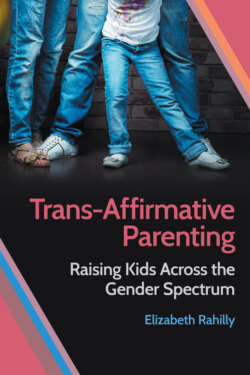Читать книгу Trans-Affirmative Parenting - Elizabeth Rahilly - Страница 17
На сайте Литреса книга снята с продажи.
Overview of the Book
ОглавлениеWith these historical and cultural trends in mind, this book turns its focus to parents’ logics for gender, sexuality, the binary, and the body, which often challenged LGBT advocacy discourses, as well as queer politics and theorizing, as much as they harnessed them. This includes parents’ deliberations between “just gay” and “truly trans” interpretations of gender nonconformity; parents’ negotiations with binary and nonbinary possibilities; and parents’ biomedical frameworks for transgender embodiment. These dynamics are explored through parents’ evolving practices and perspectives on childhood gender nonconformity, as they respond to their children over the course of early childhood development and as they become immersed in trans-affirmative education, discourses, and support networks.
Chapter 1 offers an intimate empirical portrait of the families that make up this study, including how these parents first come to view their children as gender-nonconforming and, ultimately, as transgender. Many stories have been shared about parents and trans kids, from media exposés to memoirs to documentary films, illuminating key themes and patterns across cases.108 I include a chapter like this at the outset of my analysis so that readers can know more intimately the families that populated my project, as well as to provide a critical empirical foundation for the chapters ahead. This material showcases the child-driven, child-centered nature of this phenomenon, as well as the extension of “feminist” parenting it signals. I also note important differences and caveats across cases, challenging the notion that there is any one “profile” for a transgender child. Finally, I highlight parents’ troubles with female masculinity and the “tomboy” epithet in the cases of transgender boys, as much as parents’ troubles with male femininity and “princess boys” in the cases of transgender girls.
In chapter 2, I turn to the first key area, gender and sexuality, and examine parents’ contrasts between “just gay” and “truly trans” explanations for childhood gender nonconformity. Given age-old statistics that link childhood gender nonconformity with adult homosexuality, these deliberations are no small part of parents’ journeys, nor of the historical juncture they represent. As noted earlier, mainstream LGBT rights discourses assert a firm distinction between gender and sexuality—gender identity is one thing, sexual orientation is another. However, parents’ deliberations often signaled something more fluid, and potentially permeable, between these two realms of self, gesturing to a morphing “spectrum” of possibilities. This conceptual labor, I argue, gives increasing intelligibility to explicitly (trans)gendered understandings, versus ones formerly understood within a grid of (homo)sexuality. In social-constructionist terms, this is not merely descriptive labor, but productive labor, helping to bring broadening transgender possibilities into being. Parents’ perspectives also prioritize child-rooted shifts and understandings, in a way that further troubles firm distinctions between these two categories of self.
In chapter 3, I turn to the gender binary, and discuss parents’ newfound awareness of nonbinary possibilities. These were often described as being “somewhere in the middle” of the “spectrum,” where a child “doesn’t have to be just one or the other.” Despite increasing sociopolitical emphasis on nonbinary, gender-fluid, and/or genderqueer possibilities—especially those that defy some trans-normative, gender-normative ideal—most of the children in this sample were adamantly binary-identified. For many of these parents, nonbinary possibilities proved more of an attempt to evade “truly trans” outcomes than any reality of their children’s authentic selves. In making sense of these options, parents often found themselves engaging in queer deconstructionist debates about the gender binary in parent forums, hearkening back to decades-old feminist polemics about “reifying the binary” or not. Ultimately, parents affirm the self-conceptions their children express, however “young” or “soon” this may mean for their child’s transition. In this area, I also examine several follow-up vignettes, highlighting the complications of nonbinary identities for children assigned male in particular.
Finally, in chapter 4, I turn to the area of the body, and evaluate parents’ biomedical accounts of transgender embodiment, which they often analogized to a “birth defect.” These frameworks often answered to their children’s own embodied sensibilities, and worked to protect their privacy and autonomy, but they also reiterated cisgender body logics as natural and normal, in ways that LGBTQ platforms would resist. For several of my informants, these frameworks signaled the potential erasure of a more politicized trans consciousness among these children as well—especially among those growing up within the relative safety and “normalcy” of middle-class and upper-middle class families.
In the conclusion, I synthesize these themes for a sociology of trans-affirmative parenting, highlighting the limits as well as the great liberating potential of the phenomenon. These themes exemplify parents’ love and support for their children while at the same time troubling cherished LGBTQ tenets on several key fronts: Gender and sexuality do not necessarily present as inherently disparate aspects of the precultural self, but are more fluid and open to reinterpretation, given new cultural contexts, opportunities, and awareness. “Gender-expansive” child-rearing often looks, fundamentally, very binary and gender-stereotypical, despite increasing visibility around nonbinary possibilities. And normalizing transgender experience, for many of these parents, often entails highly medicalized frameworks for bodies and genders. These families depart from conventional understandings of sex, gender, and sexuality, but in ways that prioritize child-rooted shifts and expressions, not necessarily LGBTQ paradigms.109 All told, their experiences prove new ground for understanding the mechanisms and parameters of the (trans)gender change afoot. That is a story worth sharing.
